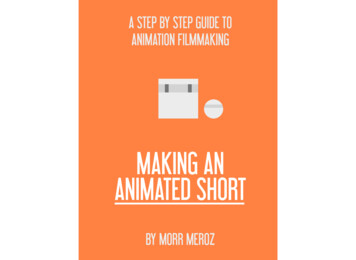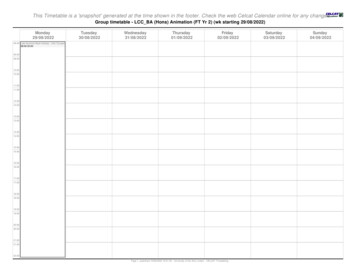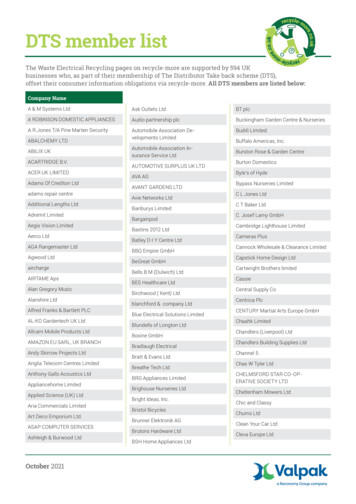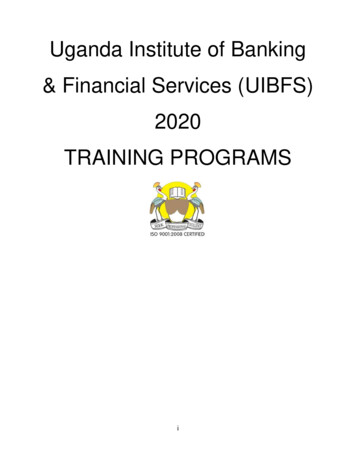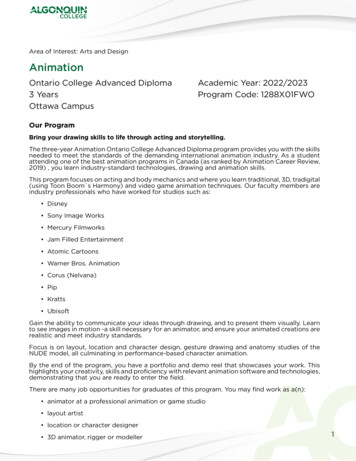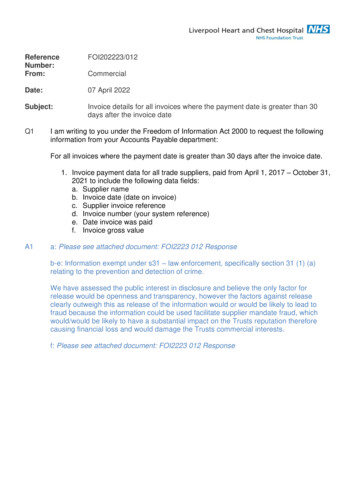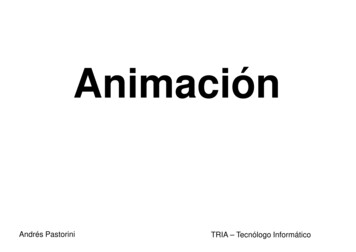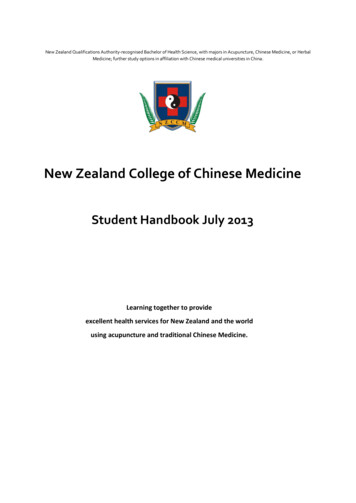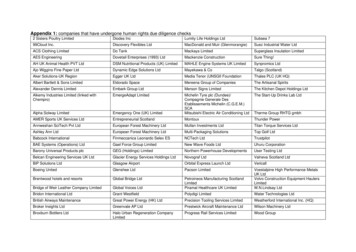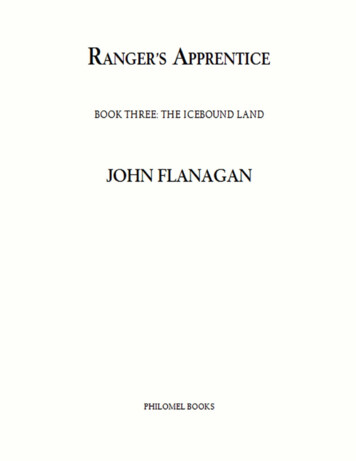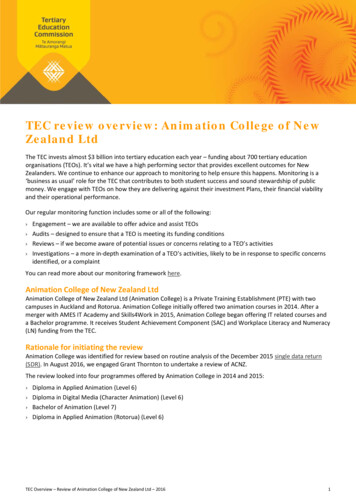
Transcription
TEC review overview: Animation College of NewZealand LtdThe TEC invests almost 3 billion into tertiary education each year – funding about 700 tertiary educationorganisations (TEOs). It’s vital we have a high performing sector that provides excellent outcomes for NewZealanders. We continue to enhance our approach to monitoring to help ensure this happens. Monitoring is a‘business as usual’ role for the TEC that contributes to both student success and sound stewardship of publicmoney. We engage with TEOs on how they are delivering against their investment Plans, their financial viabilityand their operational performance.Our regular monitoring function includes some or all of the following:››››Engagement – we are available to offer advice and assist TEOsAudits – designed to ensure that a TEO is meeting its funding conditionsReviews – if we become aware of potential issues or concerns relating to a TEO’s activitiesInvestigations – a more in-depth examination of a TEO’s activities, likely to be in response to specific concernsidentified, or a complaintYou can read more about our monitoring framework here.Animation College of New Zealand LtdAnimation College of New Zealand Ltd (Animation College) is a Private Training Establishment (PTE) with twocampuses in Auckland and Rotorua. Animation College initially offered two animation courses in 2014. After amerger with AMES IT Academy and Skills4Work in 2015, Animation College began offering IT related courses anda Bachelor programme. It receives Student Achievement Component (SAC) and Workplace Literacy and Numeracy(LN) funding from the TEC.Rationale for initiating the reviewAnimation College was identified for review based on routine analysis of the December 2015 single data return(SDR). In August 2016, we engaged Grant Thornton to undertake a review of ACNZ.The review looked into four programmes offered by Animation College in 2014 and 2015:››››Diploma in Applied Animation (Level 6)Diploma in Digital Media (Character Animation) (Level 6)Bachelor of Animation (Level 7)Diploma in Applied Animation (Rotorua) (Level 6)TEC Overview – Review of Animation College of New Zealand Ltd – 20161
Findings of the review and actions takenFindingsActions takenRecords› Minor differences between NZQA approvals andinformation submitted to the TEC in relation tolearning hours, and some inaccuracies in SDRsubmissions.› We have discussed with Animation College theimportance of ensuring its records and data areaccurate.Next StepsThis review has been completed. We are continuing to engage with Animation College through our standardmonitoring processes.TEC Overview – Review of Animation College of New Zealand Ltd – 20162
Animation College NewZealand LimitedReport to the Tertiary Education CommissionDecember 2016
Restrictions and disclaimersThis report has been prepared solely for the Tertiary Education Commission’s (TEC) exclusive usespecifically focused on the objective and scope as agreed.The scope of our work has been limited both in terms of the areas of the qualifications which wehave reviewed, and the extent to which we have reviewed them. There may be matters, other thanthose noted in this report, that might be relevant in the context of the Tertiary EducationCommission’s (TEC) funding and which a wider scope review might uncover.This report is confidential and has been prepared exclusively for TEC. It should not be used,reproduced or circulated for any other purpose, in whole or in part, without prior written consent,and such consent will only be given after full consideration of the circumstances at the time.Events and circumstances occurring after the date of our report will, in due course, render ourreport out of date and, accordingly, we will not accept a duty of care nor assume a responsibilityfor decisions and actions which are based upon such an out of date report. Additionally, we haveno responsibility to update this report for events and circumstances occurring after this date. 2016 Grant Thornton New Zealand Ltd. All rights reserved.
ContentsPageExecutive summary1Introduction4Review of programme delivery and funding conditions8Review of student records16LN Workplace Literacy Funding19Other matters20 2016 Grant Thornton New Zealand Ltd. All rights reserved.
Animation College New Zealand Limited (ACNZ)Report to the Tertiary Education CommissionDecember 20161Executive summaryOverall observations1Grant Thornton has been engaged by the Tertiary Education Commission (TEC) toconduct a review of the Animation College New Zealand Limited (ACNZ) in August 2016.2The objective of the review is to ensure that: Students have actually enrolled and attended the programmes; Programmes are taught in accordance with and comply with the learning hours and weeksentered into STEO and therefore, meet the TEC funding requirements; Programmes are delivered in accordance with learning hours approved by New ZealandQualifications Authority (NZQA) (if details are available); Students awarded a qualification have been assessed and there is evidence of programmedelivery; and ACNZ’s internal quality assurance and control processes (in relation to programme deliveryare robust and fit for purpose). 2016 Grant Thornton New Zealand Ltd. All rights reserved.
Animation College New Zealand Limited (ACNZ)Report to the Tertiary Education CommissionDecember 201683Student interviewed identified a common concern around the delivery of 2016 courses atACNZ. This mostly relate to the delivery of teaching hours as well as a lack of availablespace to work at the school following some changes made at ACNZ. As our scope is limitedto the years 2014 and 2015 we have not attempted to review or verify those concerns. Wehave obtained responses from ACNZ in relation to the concerns raised. ACNZ hasinformed us that it has changed the delivery of certain courses and Type 2 change approvalswere obtained. The issue was possibly one of ‘communication of such changes’ and not anindication of under-delivery of course content. 2016 Grant Thornton New Zealand Ltd. All rights reserved.
Animation College New Zealand Limited (ACNZ)Report to the Tertiary Education CommissionDecember 20165Definitions15 For the purposes of this report, the terms used are defined as follows based on the guidanceprovided within the NZQA Qualifications Framework: Direct hours: direct contact time with teachers and trainers; Teaching hours: direct hours plus time spent in assessments or is equal to total learninghours less self-directed hours; Self-directed hours: time spent studying and doing assignments and practical tasks; and Total learning hours: Direct hours, self-directed hours and time spent in assessment.Approach16 Grant Thornton has been engaged by the TEC to conduct a review of the specific coursesoffered by ACNZ. The scope and objectives of our review are defined within the executivesummary.17 In determining our review approach, we reviewed the information received from TEC andselected four of the programmes offered by ACNZ for review based on the level of fundingreceived in the 2014 and 2015 year and the level of LN funding. This was confirmed withthe TEC prior to contacting ACNZ. These programmes were: PC9832 - Diploma in Applied Animation (DAA) PC9833 - Diploma in Digital Media (Character Animation) (DDM) 2803 - Bachelor of Animation (BA) PC3000 - Diploma in Applied Animation (DAA Rotorua)18 We initially met with Section 9(2)(a)(College Dean) to gain an overall understanding ofACNZ. During our site visit we also met with Mr Adam Berry (Director).19 Based on our discussions with Section 9(2)(a) , we understand that both the PC9832 and PC3000courses are the same (Diploma in Applied Animation) but the different programme codesare used to distinguish which students are enrolled in Auckland or Rotorua.20 We obtained SDR returns for 2014 and 2015 from ACNZ and identified the studentsenrolled in the four programmes above. For each of the programmes, a random sample of15 students was selected for review which includes an examination of underlying records andinterview where possible. However, given the lower value for LN funding, we selected asample of 5 students for our review.21 We examined student enrolment, assessment and completion records as well as otherinformation including the QMS and relevant programme material for each of theprogrammes selected.22 The information around class times are included within the student handbooks provided tostudents. Self-study guidelines, class times and term dates are all specifically stated. We 2016 Grant Thornton New Zealand Ltd. All rights reserved.
Animation College New Zealand Limited (ACNZ)Report to the Tertiary Education CommissionDecember 20166further discussed the programme including learning hour requirements with tutors to obtainan overall understanding of the programme.23 In computing total teaching hours for each course, we took total class time per weekmultiplied by the number of weeks adjusting for holidays. In addition to this, we made afurther adjustment based on discussions with students and tutors as to self-directed studyhours required. Where there was a difference between the student’s recollection andACNZ’s documented expectation of self-directed study (where available) or the tutor’sestimates, we have used the most conservative student’s estimation.Limitations24 The terms of this engagement and the scope of the work you have asked us to undertakedoes not constitute an assurance engagement in accordance with the requirements of theChartered Accountants Australia and New Zealand (CAANZ), and is not designed toprovide assurance under International or New Zealand Standards on Auditing or Assurance.Accordingly, no assurance opinion or conclusion has been provided.25 The information contained in this report has been provided by ACNZ, TEC, NZQA, tutorsand students. Our review was based on enquiries, analytical review procedures, interviewsand exercise of judgement. Our review is also based on a small sample of students for eachselected programme. Because of the test nature and other inherent limitations of our review,there is an unavoidable risk that some material misstatements or errors may remainundiscovered.26 Our assessment of learning hours is based on discussions with staff and students and it isinherent in this approach that the view may be biased depending on who was sampled andtheir recollection of past events.27 Furthermore, our calculations are based on unrounded figures, whereas for presentationpurposes, these have been rounded to the nearest 1 decimal place. Therefore, there may beminor variations when computing total learning hours based on information presented. Inaddition, in computing actual learning hours delivered, we have deducted the hours for anypublic holidays from teaching weeks. 2016 Grant Thornton New Zealand Ltd. All rights reserved.
Animation College New Zealand Limited (ACNZ)Report to the Tertiary Education CommissionDecember 20167Principal information relied upon28 We list the principal information we have relied on in preparing our review below: ACNZ Investment plan for 2014 and 2015 TEC SDR data ACNZ's course information for the selected programmes Student Handbook for 2014 and 2015 for Auckland and Rotorua campuses ACNZ’s QMS manual Discussions with Mr Adam Berry (Director), Section 9(2)(a)(College Dean),Section 9(2)(a)(Registrar), Section 9(2)(a)(Skills4Work - National OperationsManager), Section 9(2)(a)(Skills4Work – Programme Manager Literacy &Numeracy) and various tutors involved in the courses we have selected for review Interviews with various students enrolled in the courses examined TEC STEO information NZQA approvals and RO482 for the selected programmes 2016 Grant Thornton New Zealand Ltd. All rights reserved.
Animation College New Zealand Limited (ACNZ)Report to the Tertiary Education CommissionDecember 20168Review of programme delivery and fundingconditions29 We set out below our findings on ACNZ’s programme delivery.Reconciliation of programme approval and funding requirements30 As part of our review on ACNZ’s programme delivery, it is important to ensure that theprogramme details as approved by NZQA are consistent with those approved by the TECfor funding purposes.31 For each of the programmes specified, we have compared the NZQA RO482 and TEC’sSTEO. We summarise our reconciliation below: 2016 Grant Thornton New Zealand Ltd. All rights reserved.
Animation College New Zealand Limited (ACNZ)Report to the Tertiary Education CommissionDecember 20161142 The Rotorua site commenced in 2015.43 For the DAA programme (PC9832), the STEO database records 76 teaching weeks. Thetotal number of teaching weeks based on the 2014 and 2015 student handbook was 38weeks for both years totalling 76 weeks for those who started the DAA programme in 2014.Learning hours per STEO is made up of 26 teaching hours and 6 self-directed study hours.Per the 2014 student handbook, students are required to complete 8 hours of self-directedstudy per week. This has decreased to 7 hours per week based on the 2015 studenthandbook. This is higher than the amount recorded within the STEO database.44 The DAA Rotorua programme had the first half of its course delivered in 2015. Total weeksat the Rotorua campus for the DAA Rotorua programme was 28 weeks consistent with theType 2 change submitted for the DAA programme. Learning hours per STEO is made upof 28.4 teaching hours and 8 self-directed hours. Per the 2015 Rotorua student handbook,the recommended level of self-directed study is at least 5 hours per week. This is lower thanthe amount recorded within the STEO database.45 Based on our discussions with tutors, we note that all students are provided a copy of thestudent handbook which shows the class times and expectations for the course.46 In 2014, class times for the DAA course were from 9am to 4:30 pm with a one and a halfhour break, Monday to Thursday. We were advised that whilst there are two 15 minutebreaks, students do not take the full break (some students don’t but some do take fullbreaks). Responses from two separate tutors were mixed but we have used the mostconservative estimate that the two 15 minute breaks are used as self-directed learning hours.This is then added to our estimates received from student responses around self-directedstudy. This equates to total teaching hours per day of 6.0 hours per day or 24 hours perweek. Whilst there are no classes scheduled for Fridays, classrooms are available forstudents to utilise if they wanted to and tutors were also available if required.47 In 2015, class times in Auckland for the DAA course varied depending on which year andwhat specialisation (2D or 3D) was being completed. However, overall, all the DAA courseshad 5 hours in total each day and they are required to be there from Monday to Fridaysequating to 25 hours per week.48 In 2015, for the Rotorua campus, students are required to be in class from Monday to Fridayfrom 9am to 5:00 pm with a one and a half hour break per day. We have taken a similarapproach at the Auckland campus in relation to break times. This equates to 6.5 hours perday or 32.5 hours per week.49 Based on our discussions with tutors, we note that course material is shared between theAuckland and Rotorua campuses.50 Student responses in relation to self-directed study varied significantly from no requirementto around 6 hours per week. However, we note that the most conservative estimate of selfdirected study received was the same across both sites, and therefore, we applied the mostconservative estimate of 6 hours. This is lower than the recommended self-directed studyhours within the student handbook which is a guide for students only. The additional half 2016 Grant Thornton New Zealand Ltd. All rights reserved.
Animation College New Zealand Limited (ACNZ)Report to the Tertiary Education CommissionDecember 2016142803 - Bachelor of Animation64 The BA programme is a 3 year course with an option to continue into an Honours year.There are three majors including Character and Story, World-Building and Visual Effectsand Interactive Media and Games.65 Students who have previously completed or are completing the diploma courses can takebridging courses into the Bachelors programme.66 The STEO database records total learning hours of 37.5 hours per week made up of 17teaching hours, 3 work experience hours and 17.5 self-directed study hours.67 A number of students who were enrolled in the Diploma programme in 2015 were alsoconcurrently taking bridging courses for the Bachelors programme. For these students, thebridging courses were held after their diploma courses for 2 hours each day, 5 days a weekfor 10 weeks. This equates to a total of 100 teaching hours per course. Bridging studentswere required to take two bridging papers in 2015.68 The bridging courses are 15 credits each and should equate to a total of 150 hours oflearning. Self-directed hours based on student responses suggest that students have to investa significant amount of time for self-directed study and therefore, based on responsesreceived, bridging courses meet the 150 learning hours requirement. This estimation isbased on the response from a student who was not enrolled in a diploma at the same timeand hence reflects the appropriate level of self-study required without any overlap with thediploma course requirements (in total, only 2 students completed the bridging paperswithout studying the diploma concurrently in 2015).69 For newly admitted students, the first year of the degree is delivered over 32 weeks Mondayto Thursday from 8:30 to 5pm with two and a half hour of breaks per day. Whilst therewere two half hour breaks, we understand that not all students took the full half hour breaksespecially when there are upcoming deadlines. Using the same approach as the diplomaprogrammes, the 2 half hour breaks are added to self-directed study. This equates to totallearning hours of 6.0 hours per day or 24 hours per week. These students complete a totalof six courses over the year.70 Self-directed study hour estimates by students vary significantly between 2 hours per week toaround 20 hours per week. We have grouped all students taking the Bachelor’s programmetogether (i.e. first years and those taking the bridging courses) rather than separating them.We have used the most conservative estimate provided by a student of approximately 20hours per week in calculating the assessed delivery percentage for the programme. Inaddition, we also added the 2 half hour breaks per day as self-directed study consistent withour approach used for the DAA programme.71 We have also reviewed the accreditation document ‘Application for the Approval andAccreditation of: Bachelor of Animation (Hon.) Level 8, 480 credits’ provided by ACNZ.We reviewed courses BAR01 to BAR06 which are the year 1 courses for students who arenot doing the bridging courses and calculated the teaching weeks and self-directed studyhours per week for students in year 1 of the BA programme. Based on the accreditationdocument, the teaching hours per week is higher than the average over the whole 2016 Grant Thornton New Zealand Ltd. All rights reserved.
Animation College New Zealand Limited (ACNZ)Report to the Tertiary Education CommissionDecember 201617for one of the courses they had taken that year. All other courses taken by this student didnot note a withdrawal date on the SDR return. As the student has withdrawn after the 8 daywithdrawal period, there is no refund applicable and therefore, this remains a valid domesticstudent for SAC funding purposes as per SAC3 /016.81 Another student had a withdrawal date entered as the course end date (with one daydifference) for one of the courses but not the rest of the courses, rather than including thewithdrawal date within the appropriate withdrawal date column on the SDR return.82 We identified an inconsistency in relation to the completion dates in the SDR data.Generally, we note for the majority of students reviewed, course end dates on the SDR arethe same as assessment completion dates per the assessment sheet, except where a studenthas withdrawn. Though there were some differences in dates, they were generally within thesame month and therefore, would not affect SAC funding claimed. However, for some ofthe courses for one particular student, course end dates per the SDR is the same as the actualterm end date rather than the date the student was assessed as per the student’s assessmentrecords. Another student had a course end date per the SDR which was one and a halfmonths prior to the date noted on the student’s assessment sheet. One course for anotherstudent had an end date which was one month prior to the date on the assessment sheet.PC9833 - Diploma in Digital Media (Character Animation)83 Similar to the issues identified in the DAA programme above, one withdrawn student’swithdrawal date was entered in as a course end date rather than within the appropriatewithdrawal date column on the SDR return.2803 - Bachelor of Animation84 For one of the students reviewed, no enrolment form was on file in relation to the bridgingcourses the student attended in 2015. Section 9(2)(a)This was a returningstudent and therefore, verification records were already on file.85 Apart from the matter above, no other issues were noted in relation to enrolment andverification records.86 We note that the assessment records are different to those under the diploma courses as it ison a grading system rather than whether it was completed or not. We have sighted themaster assessment sheet for a course which includes the grades achieved for each student foreach assessment.87 A transcript is not always available on Wisenet as discussed in the general section above. Asthis is a new programme offered from 2015, none of the students have completed their BAprogrammes.Attendance88 Attendance is actively monitored at ACNZ. Warning letters for non-attendance are issuedand retained in student files. Attendance requirements are also specifically noted within thestudent handbook. We have sighted withdrawal letters in student files informing students 2016 Grant Thornton New Zealand Ltd. All rights reserved.
Animation College New Zealand Limited (ACNZ)Report to the Tertiary Education CommissionDecember 201618that they have been terminated from the course due to lack of academic progress andattendance. 2016 Grant Thornton New Zealand Ltd. All rights reserved.
Animation College New Zealand Limited (ACNZ)Report to the Tertiary Education CommissionDecember 201619LN Workplace Literacy FundingWorkplace Literacy (LN) Funding89 LN funding relates to programmes delivered by Skills4Work. We met with Section 9(2)(a)as part of our review to gain an overall understanding of the workplace literacyprogrammes delivered.90 The programmes do not have set times and are customised for each company based ondiscussions with employers. Learners also set their own goals and individual learning plans.Hours attended by students are tracked based on attendance sheets. One of the mainchallenges is to accommodate employers’ and learners’ needs and work around those whendelivering the required amount of hours. In addition, Skills4Work provides a number ofcatch up sessions whereby learners who have missed a session can catch up on their learning.Learners may also attend catch up sessions even if they have not missed a class. Therefore,some learners have more than 40 learning hours delivered.91 We reviewed student files which included appropriate documentation of enrolment as wellas verification. Attendance records were checked for our sample of students and total hoursrecalculated and compared with the information returned to the TEC.92 For one of the students selected, we note that the last date of their attendance per theattendance record was the 21 January 2016. Total hours attended by this student up untilthis date match total hours as recorded in the LN reporting schedule to the TEC. However,the end date recorded for this student was on the 17 December 2015 which is the last dayattended in 2015.93 Apart from the issue noted above, there were no other issues identified during our review ofstudent records for LN funding. All students checked meet the low literacy criteria andappropriate pre- and exit assessments were either filed within the student file or accessibleonline. A copy of the completion certificates were also filed within the student files. 2016 Grant Thornton New Zealand Ltd. All rights reserved.
Animation College New Zealand Limited (ACNZ)Report to the Tertiary Education CommissionDecember 201620Other mattersStudent concerns94 Based on the interviews we have conducted with students, we identified common concernsshared by a few students around the delivery of the programmes in 2016 which are outsidethe period of our review but we consider would be appropriate to include within our report.This section of the report is collated from comments from students and does not reflect anyfurther analysis or interpretation by Grant Thornton.95 There have been significant changes in the delivery of courses in 2016. Students noted thatclass times were comparatively shorter than before and it would appear that current facilityarrangements do not adequately suit their needs.96 The reduction in class times has meant that students had less access to tutors to obtainfeedback as the tutors also had relatively busy schedules. Previously, given the number ofhours students were in class, they had comparatively more access to tutors. In addition tothe shortened class time, some students also felt that the current class times were not longenough or that they are not learning enough or that they were left to their own devices.97 Students at the Auckland campus noted that there were insufficient classrooms andcomputers for them to work on outside of class time which was different to the arrangementbefore and that sometimes, when they were able to find a free lab to work, they could notstay there for long as another class would commence. One particular student noted thatthere were more students than there is space.98 ACNZ has provided the following response to provide context in relation the reduced hoursin response to the feedback from students above:“In 2015, ACNZ commenced a process of programme harmonisation and alignment that accentuates, fostersand enables interdisciplinary opportunities across the Academic Groups of the College. This process hasincluded a review of current programme offerings that allow for future growth into the creativity and technologysectors through innovative programme offerings and delivery models.This process included a full review of programme offerings, assessment of contact versus non-contact teachingmethodologies and alignment of teacher-led versus student-led teaching styles. Current staff and students aswell as external industry and community stakeholders were consulted through this process, which resulted in aCategory 2 change being successfully completed between November 2015 and February 2016. 2015 deliverywas benchmarked against local and international delivery models and proposed changes were aligned with besteducational practice. 2016 Grant Thornton New Zealand Ltd. All rights reserved.
Animation College New Zealand Limited (ACNZ)Report to the Tertiary Education CommissionDecember 201621The main areas of focus for this review and programme change included: significant pedagogical shift from teacher- to student-led delivery; a shift away from 1 teacher 1 classroom to flexible classrooms, multiple teachers per group andgroup and team-based learning; introduction of Moodle and flipped learning methodology to assist with new delivery paradigm; face-to-face delivery ratio to structured self-directed learning; effective staffing, allocation of workload, content development and programme review; and timetabling.The new model was introduced to students through the Orientation phase of the new academic year inFebruary 2016 and in 1:1 conversations with students prior to the first week of teaching. Staff underwentworkshop training on developing briefs to teaching within a new teaching paradigm and linking to assessmentand moderation. The College was cognizant of the legacy associated with students moving from a high contact/ teacher focussed delivery model to self-managing, staff moderated, student-led model. This was exacerbatedat times due to the legacy of staff working in a classroom model for a number of years.Aligned with this, was the introduction of the Bachelor of Creative Software in 2016 which deliversprogramme and project content through the updated delivery model. Delivery in each year of the programme isidentical to that of the Bachelor of Animation with extraordinarily high levels of student engagement, outcomeand satisfaction. The management team are aware of the legacy and historical context within which the ADstudents operates and provides students with opportunities to provide feedback on delivery, staffing andresources through the student representation and feedback cycle and the appointment of student members to theACNZ Academic Board Committee.” 2016 Grant Thornton New Zealand Ltd. All rights reserved.
2016 Grant Thornton New Zealand Ltd. All rights reserved.“Grant Thornton” refers to the brand under which the Grant Thornton member firms provideassurance, tax and advisory services to their clients and/or refers to one or more member firms, as thecontext requires. Grant Thornton New Zealand is a member firm of Grant Thornton International Ltd(GTIL). GTIL and the member firms are not a worldwide partnership. GTIL and each member firm isa separate legal entity. Services are delivered by the member firms. GTIL does not provide services toclients. GTIL and its member firms are not agents of, and do not obli
Animation College of New Zealand Ltd ( Animation College) is a Private Training Establishment (PTE) with two campuses in Auckland and Rotorua. Animation College initially offered two animation courses in 2014. After a merger with AMES IT Academy and Skills4Work in 2015, Animation College began offering IT related courses and a Bachelor programme.
